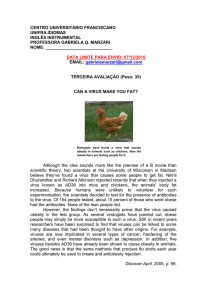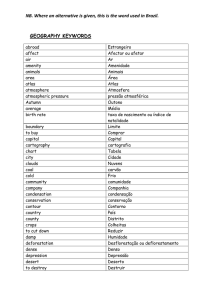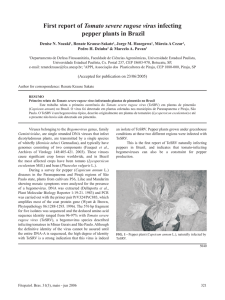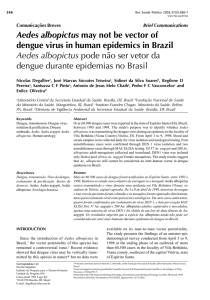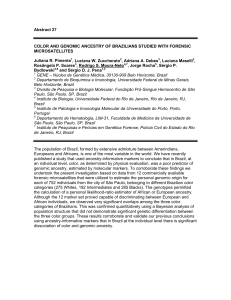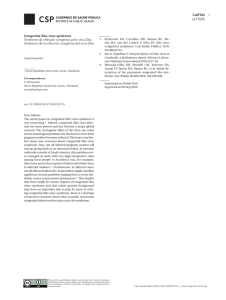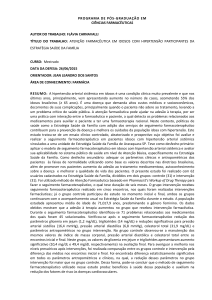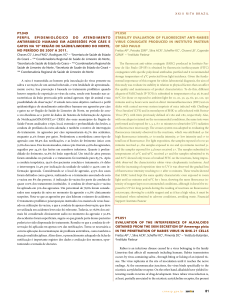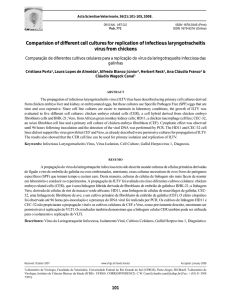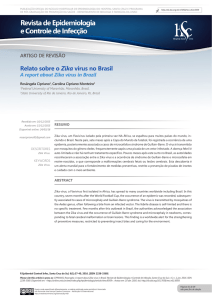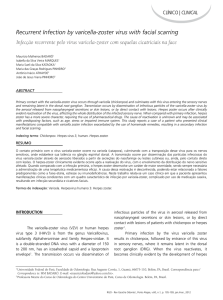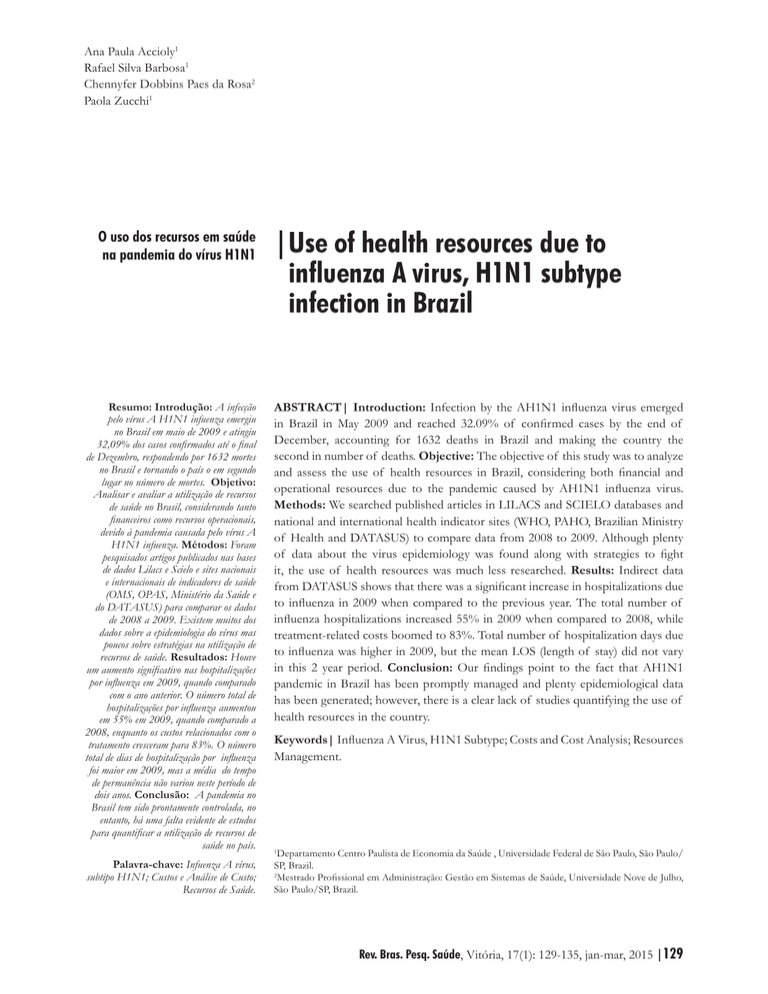
Ana Paula Accioly1
Rafael Silva Barbosa1
Chennyfer Dobbins Paes da Rosa2
Paola Zucchi1
O uso dos recursos em saúde
na pandemia do vírus H1N1
Resumo: Introdução: A infecção
pelo vírus A H1N1 infuenza emergiu
no Brasil em maio de 2009 e atingiu
32,09% dos casos confirmados até o final
de Dezembro, respondendo por 1632 mortes
no Brasil e tornando o país o em segundo
lugar no número de mortes. Objetivo:
Analisar e avaliar a utilização de recursos
de saúde no Brasil, considerando tanto
financeiros como recursos operacionais,
devido à pandemia causada pelo vírus A
H1N1 infuenza. Métodos: Foram
pesquisados artigos
publicados nas bases
de dados Lilacs e Scielo e sites nacionais
e internacionais de indicadores de saúde
(OMS, OPAS, Ministério da Saúde e
do DATASUS) para comparar os dados
de 2008 a 2009. Existem muitos dos
dados sobre a epidemiologia do vírus mas
poucos sobre estratégias na utilização de
recursos de saúde. Resultados: Houve
um aumento significativo nas hospitalizações
por influenza em 2009, quando comparado
com o ano anterior. O número total de
hospitalizações por influenza aumentou
em 55% em 2009, quando comparado a
2008, enquanto os custos relacionados com o
tratamento cresceram para 83%. O número
total de dias de hospitalização por influenza
foi maior em 2009, mas a média do tempo
de permanência não variou neste período de
dois anos. Conclusão: A pandemia no
Brasil tem sido prontamente controlada, no
entanto, há uma falta evidente de estudos
para quantificar a utilização de recursos de
saúde no país.
Palavra-chave: Infuenza A vírus,
subtipo H1N1; Custos e Análise de Custo;
Recursos de Saúde.
|Use of health resources due to
influenza A virus, H1N1 subtype
infection in Brazil
ABSTRACT| Introduction: Infection by the AH1N1 influenza virus emerged
in Brazil in May 2009 and reached 32.09% of confirmed cases by the end of
December, accounting for 1632 deaths in Brazil and making the country the
second in number of deaths. Objective: The objective of this study was to analyze
and assess the use of health resources in Brazil, considering both financial and
operational resources due to the pandemic caused by AH1N1 influenza virus.
Methods: We searched published articles in LILACS and SCIELO databases and
national and international health indicator sites (WHO, PAHO, Brazilian Ministry
of Health and DATASUS) to compare data from 2008 to 2009. Although plenty
of data about the virus epidemiology was found along with strategies to fight
it, the use of health resources was much less researched. Results: Indirect data
from DATASUS shows that there was a significant increase in hospitalizations due
to influenza in 2009 when compared to the previous year. The total number of
influenza hospitalizations increased 55% in 2009 when compared to 2008, while
treatment-related costs boomed to 83%. Total number of hospitalization days due
to influenza was higher in 2009, but the mean LOS (length of stay) did not vary
in this 2 year period. Conclusion: Our findings point to the fact that AH1N1
pandemic in Brazil has been promptly managed and plenty epidemiological data
has been generated; however, there is a clear lack of studies quantifying the use of
health resources in the country.
Keywords| Influenza A Virus, H1N1 Subtype; Costs and Cost Analysis; Resources
Management.
Departamento Centro Paulista de Economia da Saúde , Universidade Federal de São Paulo, São Paulo/
SP, Brazil.
2
Mestrado Profissional em Administração: Gestão em Sistemas de Saúde, Universidade Nove de Julho,
São Paulo/SP, Brazil.
1
Rev. Bras. Pesq. Saúde, Vitória, 17(1): 129-135, jan-mar, 2015 |129
Use of health resources due to influenza A virus, H1N1 subtype infection in Brazil | Accioly et al.
INTRODUCTION|
In March and April 2009, cases of acute respiratory
syndrome related to the AH1N1 influenza virus were
described in Mexico and the United States (USA),
identifying a new influenza A virus1,2.
Virus detection was based on exams conducted in two
children in California, United States in 20093. It was a
new virus, with a different genotype from the other A
viruses (aviary, swine or human AH1N1), being the latter
responsible for the Spanish flu of 1918. The rapid spread in
the Northern hemisphere in the following weeks, reaching
Europe in May4 and on June 11th, prompted the World
Health Organization (WHO) to raise AH1N1 influenza
AH1N1 to the highest level of alert (level 6), officially
declaring that the world was facing a new flu pandemic4.
On April 25th, 2009, when a Public Health Emergency of
International Importance (PHEIC) was declared by WHO,
the Brazilian government carried out a series of measures5,
such as follows:
•
Setting up of the Permanent Bureau of Public Health
Emergency, to monitor the situation and indicate the
appropriate measures for the country;
•
Provision of medicines for all the federal units;
•
Creation and distribution of technical materials for
the guidance of professionals, with simultaneous
update from robust scientific evidence and WHO
guidelines;
•
Purchase of vaccines, medicines, personal protective
equipment (such as masks and gloves), improvement
of the care network, and communication (inserts on
broadcast, Internet, newspapers, airports);
•
Expansion of the diagnosis network by Real-time
polymerase chain reaction (RT-PCR) in government
laboratories;
•
Provision of direct communication channels through
the Health Hotline (0800 61 1997);
•
Investment in research about the conditions of risk
for complications (factors and groups);
•
Production and purchase of vaccines against
pandemic influenza (AH1N1) 2009.
Infection by the AH1N1 influenza virus emerged in
Brazil in May 2009 and reached 32.09% of confirmed
cases by the end of the same year. There were 86,767
diagnosed cases of SARS (Severe Acute Respiratory
Syndrome), being 27,850 (32.09%) confirmed by the
pandemic virus which accounted for 1,632 deaths in
Brazil, the second country in number of deaths5. The
main risk factors for death in Brazil were comorbidities
and pregnancy, since they were present in 882 deaths
(54%) and 155 (9.55%), respectively5.
The peak of incidence of SARS cases occurred between
epidemiological weeks 29 and 38, which correspond to the
months of August to October of 2009, as shown in Table 15.
Of all these cases, more than 90% of the isolated influenza
viruses during this period were positive for the pandemic
virus AH1N1, as shown in Table 25.
The most affected region by the pandemic virus was the
South region, followed by the Southeast region5:
In 2009, the incidence rate of SARS due to influenza
AH1N1 in Brazil was 14.5/100,000 inhabitants, and the
mortality rate was 0.85/100,000 inhabitants5.
On August 10th, 2010, the WHO declared that the AH1N1
Pandemic Influenza 2009 reached the post–pandemic
phase. In the same year, 9,473 SARS cases were reported
and suspected patients were hospitalized in all five regions
of Brazil. Of these, there were 801 (8.45%) confirmed
cases of AH1N1 influenza and 104 (1.09%) deaths6.
The aim of this study was to assess and analyze the use
of health resources in Brazil, considering financial and
operational resources as a result of the pandemic caused
by AH1N1 in Brazil, from April 2009 to December 2010.
METHODS|
We searched the LILACS and SCiELO databases for articles
dealing with the use of health resources in 2009 AH1N1
pandemic virus in Brazil, through the Virtual Health Library
(VHL) portal. Health Sciences Descriptors (DeCS) used:
influenza A (filter resource# cost#) and influenza AH1N1.
A search was also carried out on the official government sites:
http://portalsaude.saude.gov.br/ and http://www2.datasus.
gov.br/DATASUS/index.php?area=02 to compare data from
2008 to 2009. Data from international health organizations
such as WHO and Pan American Health Organization
130| Rev. Bras. Pesq. Saúde, Vitória, 17(1): 129-135, jan-mar, 2015
Use of health resources due to influenza A virus, H1N1 subtype infection in Brazil | Accioly et al.
(PAHO) were also searched. Access dates: February 26th,
2010 and November 25th, 2010 for LILACS and SCIELO and
January 11th, 2011 for National Health System (DATASUS).
Variables searched on official government sites included:
hospitalizations due to influenza/pneumonia both in 2008
and 2009, their length of stay and associated costs as well
as the number of deaths in both years.
RESULTS|
In the VHL/ LILACS survey using Influenza A as DeCS,
560 matches were found. Using AH1N1 as DeCS, nine
matches were obtained. When a filter for resource# or
cost# was used, no matches were found.
In the VHL/ SCIELO search using Influenza A as
DeCS, 336 matches were obtained. When we filtered by
year (2009) and country (Brazil), the search delivered 21
matches. Seven matches were found for AH1N1, while
LILACS search, using the resource# or cost# filter, did not
deliver any matches.
Machado7 was the first author to publish an article on
AH1N1 Influenza virus infection in Brazil, in May 2009
when the first cases of infection were diagnosed in the
country. The article draws attention to the new infection
and describes how to recognize, diagnose and treat cases7.
In June 2009, an article by Carmo and Oliveira8 from
the Health Surveillance Secretariat, Ministry of Health,
was published even before the pandemic was officially
declared, describing the characteristics of the infection:
prevalence in children and young adults and a low mortality
(<1%), predominantly mild to moderate flu-like illness
symptoms and a higher frequency of deaths in patients
with underlying chronic illnesses. The article also outlined
the main strategies set up by the Health Ministry to fight
the epidemics: the structuring and strengthening of public
health services for early detection and effective response to
public health emergencies8.
Another study by Duarte et al.4 conducted in State of Paraná
showed that among the 63 patients over 12 hospitalized
due to AH1N1 influenza in a 45 day period, 39.7% evolved
to death. In this same period, 11% of admissions to
Intensive Care Units (ICUs) were due to AH1N1. In at
least one of the hospitals included in the study, a special
unit was created to take care of AH1N1patients. Moreover,
as a strategy of the health system, measures were taken to
reduce the number of elective surgeries in public hospitals
in the state, trying to temporarily reduce some indications
of ICU admissions4.
A study conducted at Hospital das Clínicas, University
of São Paulo, by Schout et al.9, comments on the
establishment of a crisis committee in the service to
receive AH1N1 patients, comprising strategies for
prevention, epidemiological surveillance, availability of
rapid diagnostic tests, antiviral treatment, and training of
hospital staff, including a specialized intensive care unit
and ward. Among the 210 patients admitted to the hospital
due to AH1N1 influenza, most of the cases (86 patients
- 41%) were admitted to the Central Institute of Hospital
das Clínicas with an average length of stay of 9.4 days. At
Instituto da Criança, 64 children were admitted (30% of
the 210 patients hospitalized) with an average length of
stay of 5.7 days. The same service published a guideline for
the management of the pandemic10.
Verrastro et al.11 published an article on the radiological
manifestations caused by AH1N1virus in chest
computerized tomography11.
In another article12, the Minister of Health of Brazil in
2009, José Gomes Temporão, reported the measures
taken by Sistema Único de Saúde (SUS) in the country,
in accordance with states and municipalities, for effective
action in combating the pandemic including:
• Monitoring and surveillance activities;
• Notifications of cases;
• Monitoring of ports, airports and borders;
• Recommendations to travelers;
• Assistance to cases and contacts;
• Disclosure to the media;
• Structuring of health networks;
• Acquisition of materials and treatments;
• Development of capacity for the production of the
vaccine against influenza A (AH1N1) virus.
In this article, the Minister refers to the National Network
for Influenza Diagnosis, introduced in Public Health Central
Rev. Bras. Pesq. Saúde, Vitória, 17(1): 129-135, jan-mar, 2015 |131
Use of health resources due to influenza A virus, H1N1 subtype infection in Brazil | Accioly et al.
laboratories in all states and the Federal District, and also in
the 53 hospital referral units for monitoring and treatment
of patients with influenza AH1N1 infection, with 1,270 beds
reserved by the State Departments of Health12.
In addition to the literature review a search in DATASUS
was conducted on infection by AH1N1 influenza virus.
There is no information on hospitalization, checkups or
use of drugs resulting from infection by the pandemic
virus. The survey of hospital admissions for influenza (not
typed) occurred in all age groups, and in all regions of the
country in 2009 added up to 42,869 cases, 55% more than
the numbers reported in 2008 (27,583)16.
To combat the 2009 - 2010 pandemic, the federal
government purchased 113 million doses of the pandemic
vaccine in early 2010, with a total cost of US$ 180 million
arising from an interim measure, including expenses for the
operation of the campaign. This campaign was conducted
in 36,000 vaccination sites around the country, under the
responsibility of the State Departments of Health13.
The cost of hospitalizations for influenza mentioned
above was US$ 19,044,259.99, approximately three times
the value from the previous year, 2008, US$ 7,748,282.34,
as shown in Table 116.
The measures taken in different health services were in
accordance with the guidelines for combating the pandemic
of São Paulo State Department of Health, as published in
the Journal of Public Health (Revista de Saúde Pública)14.
When analyzing the number of hospitalization days due
to influenza in 2009, we found that they reached 202,672
days, while in 2008 this number was 135,435 days, a 49%
increase. When we looked at the average length of stay of
each individual hospitalized for influenza, there was a small
difference between the two years (average stay of 4.9 days
in 2008 and 4.7 days in 2009).
Ercole et al (2009) also carried out a literature review on
national and international databases about swine flu. Forty
publications were found, with 18 forming the basis for
an article about the infection, its etiology, epidemiology,
prevention and treatment strategies. None of the articles
mentioned by the author made reference to the use of
health resources during the pandemic15.
It is important to note that the peak of admissions
coincided with the months of largest circulation of the
pandemic virus, as seen in Table 2.
Table 1 - Basic information and cost of AH1N1 virus pandemia in Brazil in 2008 and 2009
Years
Information
Total cost of hospitalizations (US$)
2008
2009
∆ 2009/2008 (%)
7,748,282.34
19,044,259.99
145%
# of cases
27.583
42.869
55%
Mean hospitalization cost (US$)
278.99
441.65
58%
Total LOS (days)
135.435
202.672
49%
Mean LOS (days)
4,9
4,7
-5%
# of deaths
755
1.426
88%
Source: DATASUS, 2008-2009.
Table 2 - Hospitalization expenses in Brazil in 2008 and 2009.
Expenses
# of AIH
Total Cost (US$)
Mean AIH value (US$)
Years
∆ 2009/2008 (%)
2008
2009
760.729
867.105
13%
230,209,670.52
391,109,579.60
70%
302.61
451.05
50%
Source: DATASUS, 2008-2009.
132| Rev. Bras. Pesq. Saúde, Vitória, 17(1): 129-135, jan-mar, 2015
Use of health resources due to influenza A virus, H1N1 subtype infection in Brazil | Accioly et al.
Regarding the number of deaths due to influenza, there
was a considerable increase from one year to another, 1,426
deaths in 2009 versus 755 in 2008 (88% increase).
Data from DATASUS on hospitalizations for pneumonia
or flu showed that in 2009 867,105 Hospital Admission
Authorization (AIH) were generated for the treatment
of pneumonia/flu with a total cost of approximately
US$ 391,109,579.60, which means an increase of US$
160,899,909.00 in relation to the previous year. There
was an increase of 70% in costs in 2009 compared to the
U$ 230,020,9670.00 spent in 2008 for the treatment of
pneumonia/ flu (with a total of 760,729 AIH). The mean
AIH value increased from US$ 302.61 in 2008 to US$
451.05 in 200917 (a 50% increase in the average cost per
hospitalization for pneumonia/flu from 2008 to 2009).
The search in the same site for information on outpatient
service showed that there was only availability of data
on outpatient visits per year, without specific diagnosis,
making it impossible to determine whether the AH1N1
influenza pandemic represented an increase in outpatient
care or emergency services in country.
In the beginning of year 2010, the Ministry of Health of
Brazil issued a technical note on the strategy for AH1N1
vaccination program:
• A credit of US$ 80,978,635.42 and US$
1,206,064,782.91 billion was earmarked for the
purchase of vaccines, medicines, personal protective
equipment (such as masks and gloves), improvements
in health care network and communication;
•
Eighty-three million doses of monovalent pandemic
vaccine (AH1N1) were purchased by the government
for vaccinating priority groups starting in March
2010, according to the analysis of more severe cases
occurring in the country. The aim of the campaign
was to maintain the functioning of health services
involved in the response to the pandemic and to reduce
morbidity and mortality associated with the virus.
The following groups were chosen to be vaccinated in
order of priority:
• Health professionals;
• Indigenous population;
• Pregnant women;
• People with chronic diseases;
• Children aged six months to two years;
• Adults aged 20 to 39.
The elderly group was not primarily affected by the
pandemic virus, so they were to receive the bivalent vaccine
against seasonal influenza, which does not contain the
AH1N1/California/7/2009 virus, unless they presented
comorbidities18.
DISCUSSION|
Reviewing available data on AH1N1 pandemic in Brazil, it
is clear that prompt measures were taken by the Ministry of
Health to address that emergency situation in the country,
as well as the concern of medical writers to describe the
clinical findings of infection in the assisted population in
the country.
Awareness raising campaigns and guidance were conducted
by the Ministry of Health throughout the country, and
containment measures were taken.
There is much information available about the epidemiology
of the disease in the country, number of cases, most
affected region, the profile of patients who died, as well as
data on how the country got prepared to face the pandemic.
However, little information was found in government
technical notes and on DATASUS site about costs and
number of beds available for the treatment of patients
affected by the pandemic virus and so far we have not
found a single study quantifying the use of health resources
for the management of the pandemic in the country.
In the analysis of DATASUS information, the findings are
related to influenza infection and not specific to AH1N1
virus infection. Even in the absence of specific data on
the pandemic virus, a way to analyze its impact on the
use of health resources in the country was to compare
the number of hospitalizations due to influenza in the
year 2008 to admittances in 2009, which showed a 55%
increase. This increase accounted for an 83% rise in the
cost of hospitalizations due to influenza in the year 2009
when compared to the previous year.
Rev. Bras. Pesq. Saúde, Vitória, 17(1): 129-135, jan-mar, 2015 |133
Use of health resources due to influenza A virus, H1N1 subtype infection in Brazil | Accioly et al.
Although DATASUS information on hospitalizations due
to influenza are not classified by type of virus, in 2009
more than 80% of circulating influenza viruses had been
identified as the pandemic virus; thus, it may be assumed
that this increase in the number and cost of hospitalizations
due to influenza is largely due to the pandemic virus.
An increase in the cost of hospitalization for pneumonia/
influenza in 2009 versus 2008 is also observed in DATASUS
(26% increase in the total cost), and although this diagnosis
includes both bacterial and viral cases, we may also infer
that the pandemic virus has played an important role in
this increase.
Another aspect analyzed in DATASUS was the length of
hospital stay due to influenza, which in 2009 was 49% higher
than the previous year. This may very well indicate that the
influenza virus circulating in 2009 was more morbid than
the virus circulating in 2008. However, we should point out
that no statistical analysis was performed in this study and
that the influenza subtype causing hospitalization was not
diagnosed in either year.
The number of deaths among individuals hospitalized
due to influenza was 88% higher in 2009 when compared
to 2008 (1,426 vs. 755 deaths), but since the number of
hospitalizations due to influenza was also considerably
higher in 2009 and no statistical analysis was performed, it
is not possible to determine whether the difference in the
total number of deaths in 2009 is statistically significant
(3.32% in 2009 vs. 2.73% in 2008).
Ercole et al.15 published an article using a similar
methodology to that used in this paper. Although his
literature search was broader, no cost evaluations of
AH1N1 virus infection were mentioned. Until the end
of the research, no study had been published on the use
of financial and operational resources as a result of the
pandemic caused by the AH1N1 virus in Brazil.
Besides searching the available literature in Brazil, this
study proposed the analysis of DATASUS information on
influenza and pneumonia/influenza in 2008 and 2009, when
the pandemic occurred. This analysis attempted to assess
the social and economic impact of the pandemic in Brazil
and although we cannot make strong assumptions about
it, since the influenza subtype that led to hospitalization
was not diagnosed. However, it seems quite logical to credit
the increase in number of hospitalizations in 2009 to the
pandemic virus, as it accounted for around 80% of isolated
influenza virus in 2009 during the peak of influenza season.
Studies that seek to measure the impact on the use of health
resources resulting from situations such as the pandemic
are relevant to the country, as the scarce resources available
should be applied efficiently. This body of knowledge, by
affecting the perceptions of agents regarding health costs
and benefits, can help promote strategies for the prevention
and control of the diseases affecting the country.
CONCLUSION|
While we may say that AH1N1 pandemic in Brazil was
promptly managed and many epidemiological data has
been generated, there is no study quantifying the use of
health resources in the country. In the few Brazilian articles
on the topic, pandemic virus infection was mentioned as
an important cause of ICU hospitalizations and length of
hospital stay was described in some patients with AH1N1
infection.
These indirect analyses suggest that AH1N1 pandemic
represented an increase in health resources use in Brazil,
both financial and operational, but there is room to plan
and develop health economic studies in the country with
the aim of evaluating a proper way of using the scarce
resources in the most effective manner.
REFERENCES|
1. Update: swine influenza A (AH1N1) infectionsCalifornia and Texas, April 2009. MMWR Morb Mortal
Wkly Rep. 2009; 58:435-7.
2. Update: novel influenza A (AH1N1) virus infection Mexico, March-May, 2009. MMWR Morb Mortal Wkly
Rep. 2009; 58:585-9.
3. Swine influenza A (AH1N1) infection in two childrenSouthern California, March-April 2009. MMWR Morb
Mortal Wkly Rep. 2009; 58:400-2.
4. Duarte PAD et al. Pacientes com infecção por vírus
A(H1N1) admitidos em unidades de terapia intensiva do
134| Rev. Bras. Pesq. Saúde, Vitória, 17(1): 129-135, jan-mar, 2015
Use of health resources due to influenza A virus, H1N1 subtype infection in Brazil | Accioly et al.
Estado do Paraná, Brasil. Rev Bras Ter Intensiva. 2009;
21(3):231-6.
5. Informe epidemiológico. Influenza pandêmica (AH1N1)
2009. Situação epidemiológica da Influenza Pandêmica
(AH1N1) 2009 no Mundo e no Brasil, até a Semana
Epidemiológica 47 de 2009. Available at: URL: <http://
portal.saude.gov.br/portal/arquivos/pdf/boletim_
influenza_se_47.pdf>. Accessed on February 26, 2010.
6. Informe Técnico - Influenza Pandêmica AH1N1 2009.
Fase pós-pandêmica – Atualização. Available at: URL:
<http://www.cve.saude.sp.gov.br/htm/resp/pdf/IF11_
INFLUENZA_2701.pdf>. Accessed on January 11, 2011.
7. Machado AA. Infecção pelo vírus Influenza A (AH1N1)
de origem suína: como reconhecer, diagnosticar e prevenir.
J Bras Pneumol. 2009; 35(5):464-9.
8. Carmo EH; Oliveira WK. Risco de uma pandemia de
influenza pelo vírus A (H1N1)/ The risk of a pandemic
with the influenza A (H1N1) virus. Cad. Saúde Pública.
2009; 25(6):1192.
9. Schout D et al. Epidemiology of human infection with
the novel virus influenza A (H1H1) in the Hospital das
Clínicas, São Paulo, Brazil. CLINICS 2009. 64(10):1025-30.
10. Hajjar LA et al. Guidelines on management of human
infection with the novel virus influenza A (H1N1): a report
from the Hospital das Clínicas of the University of São
Paulo. CLINICS 2009. 64(10):1015-24.
11. Verrastro CG et al. Manifestações da infecção pelo novo
vírus Influenza AH1N1 na tomografia computadorizada
de tórax. Radiol Bras. 2009; 42(6):343-8.
Epidemiológica “Prof. Alexandre Vranjac”. Coordenadoria
de Controle de Doenças Características dos casos
notificados de Influenza A/AH1N1. Rev Saúde Pública
[online]. 2009;43(5).
15. Ercole FF et al. Protocolo de cuidado frente à Influenza
A AH1N1: informações para os profissionais da saúde.
Nursing (São Paulo). 2009; 12(135):369-74.
16. Brasil. Ministério da Saúde. Datasus. Available at : URL:
<http://tabnet.datasus.gov.br/cgi/tabcgi.exe?sih/cnv/
niuf.def>. Accessed on February 26, 2014.
17. Brasil. Ministério da Saúde. Datasus. Available at : URL:
<http://tabnet.datasus.gov.br/cgi/tabcgi.exe?sih/cnv/
qiuf.def>. Accessed on November 25, 2014.
18. Brasil. Ministério da Saúde. Datasus. Nota técnica
No 05/2010 DEVEP/SVS/MS Estratégia de Vacinação
contra o Vírus de Influenza A (H1N1) 2009 Pandêmico
e sazonal. Available at: URL: <http://portal.saude.gov.br/
portal/arquivos/pdf/nota_tecnica_05_2010_atual.pdf>.
Accessed on February 26, 2014.
Correspondência para/Reprint request to:
Paola Zucchi
Rua Botucatu, 740, 3º andar
São Paulo - SP - Brasil
CEP: 04023-900
Tel.: (11) 5576-4848
E-mail: [email protected]
Submetido em: 09/12/2014
Aceito em: 04/06/2015
12. Temporão, José Gomes. O enfrentamento do Brasil
diante do risco de uma pandemia de influenza pelo vírus A
(H1N1). Epidemiol Serv Saúde. 2009;18(3):201-4.
13. Brasil. Ministério da Saúde. Influenza A (H1N1) MS amplia faixa etária para a vacinação contra gripe A.
Available at : URL: <http://www.cpqrr.fiocruz.br/pt-br/
pesquisa/influenza AH1N1>. Accessed on November
25, 2010.
14. Secretaria de Estado da Saúde de São Paulo. Divisão de
Doenças de Transmissão Respiratória Centro de Vigilância
Rev. Bras. Pesq. Saúde, Vitória, 17(1): 129-135, jan-mar, 2015 |135

